

 STUART JORDAN finishes his history the history of the Metropolitan Railway.
STUART JORDAN finishes his history the history of the Metropolitan Railway.
We’ve previously seen in this series how the first underground railway was built and how it expanded across London. We’re now at the turn of the 20th Century with the prospect of modern ideas like electrification and suburbs on the horizon.
By 1900, the Metropolitan Railway had increasing competition from recently built deep level lines like the City & South London, Waterloo & City, and the Central London Railway (CLR); the CLR especially, as their line ran from Shepherds Bush to Bank close to the Met’s Moorgate and the District’s Mansion House stations. Known as the ‘Twopenny Tube’ because of the flat rate fare, the opening of the CLR led to the Met losing four million customers between 1899 and 1900.
Another factor was that the Met was still running steam traction which lead to a polluted atmosphere in the underground tunnels. Electrification was seen as the way forward. An experimental train made up of six coaches jointly owned by the Met and the District Railway, made test runs in 1900 between Earl’s Court and High Street Kensington.
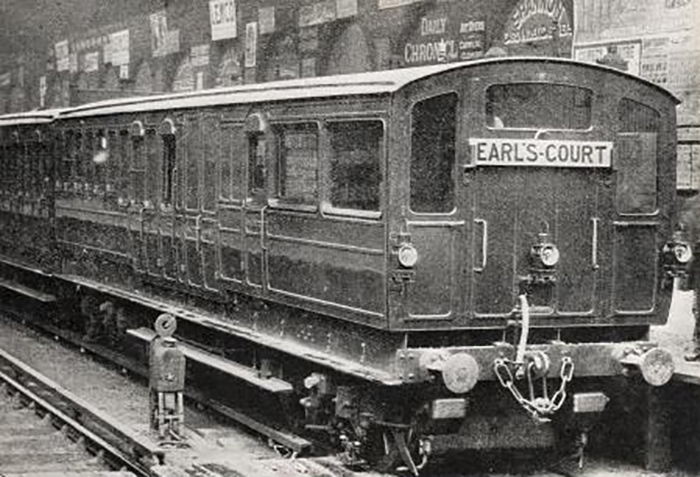
The joint Metropolitan/District experimental electric train.
The tests were successful, so in 1901 tenders to build electric locomotives were requested. A Three-Phase AC power system developed by Ganz in Hungary was intended to be used with the locomotive drawing power from an overhead cable. This all changed, however, when the District was taken over by the Underground Electric Railways Company of London (UERL) led by Charles Yerkes. Yerkes was American and championed a DC third-rail system which, coincidentally, was already being used on two other London lines. The Board of Trade arbitrated and settled on a four-rail system. In 1904 the Met opened a power station in Neasden to provide the energy for the new electric network. The first V Class electric multiple units began running on 1st January 1905. The GWR built a power station in Park Royal and electrified the line between Paddington and Hammersmith, and the branch to Kensington. By 1908, all the main lines on the Met had been electrified.
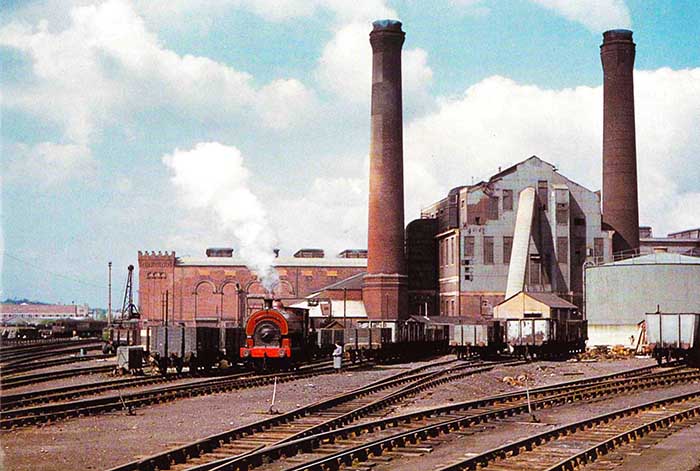
The Neasden Power Station built to power the Met.
Although EMUs were used, conventional carriage stock was pulled by electric locomotives. Initially, ten locomotives were ordered from Westinghouse. These central cab ‘camel-backs’ entered service in 1904. A year later, ten more locomotives built to a box car design with British Thomson Houston control equipment entered service.
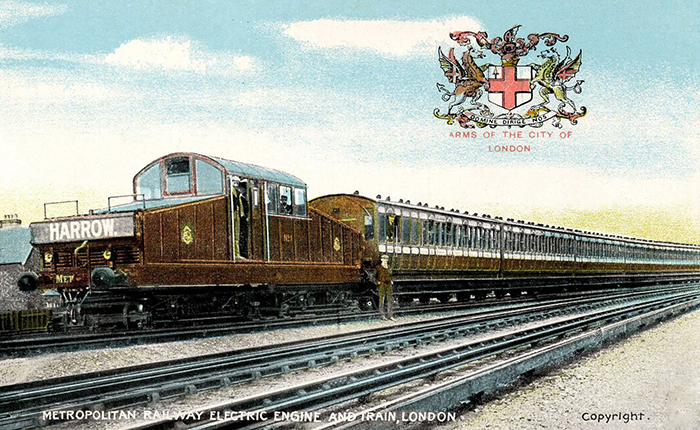
Postcard showing one of the early 'camel-back’ electric locomotives.
In 1908 the underground railway companies in London arranged a joint marketing drive to promote travel. The whole network was branded as UNDERGROUND, with branded signs and maps put up outside stations. The UERL subsumed all the other lines besides the Met and the Waterloo & City and introduced the familiar station signs with a blue bar on a red circle. The Met responded by producing their own signs with a red diamond instead of a circle. Some of these signs are still visible today.
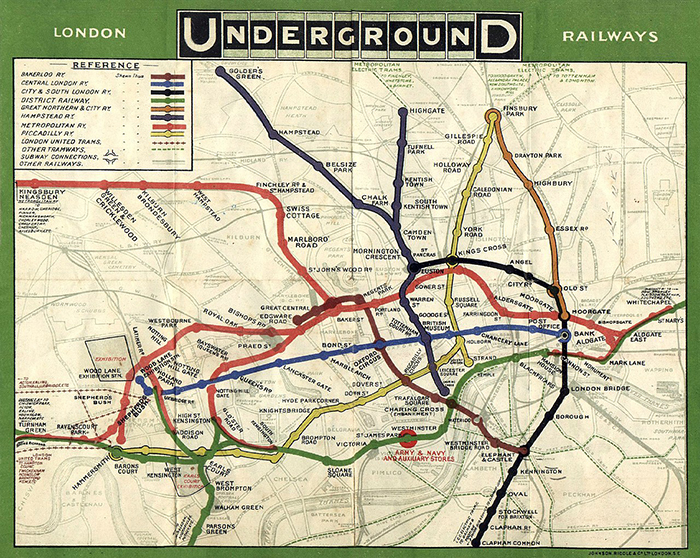
1908 UNDERGROUND map, showing the Met in red.
The Met General Manager, Robert Selbie, resisted a merger with UERL in a statement in 1912. When war broke out in 1914 the Met, along with all other railways in Britain, was put under government control. The ‘Widened Lines’ became of strategic importance, as they were a link between the Channel ports and the main lines to the north of the country. With so many male staff volunteering for military service, women were employed as booking clerks and ticket collectors for the first time.
The war had delayed one of Selbie’s plans – creating a separate company to develop the Met’s surplus land. Other railway companies had to dispose of surplus land, but through various clauses the Met was able to keep any land that they felt could be put to future railway use. Before the war, parcels of land had been sold off to developers as they became available. In 1912 the Metropolitan Railway Country Estates Limited was formed after legal advice was given that the Met could hold the land but not develop it.
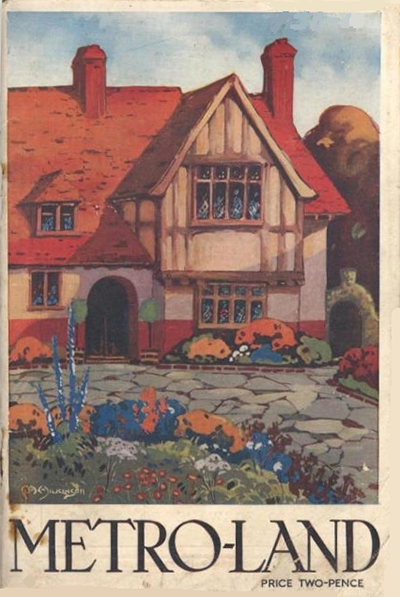
1921 Metro-land guide, showing the idyllic scene that the Met was trying to put across for their new estates.
The new company built new estates in the North-West London towns of Neasden, Wembley Park, Pinner, Rickmansworth, and built whole villages like Harrow Garden Village. These estates were characterised by the ‘Tudor Revival’ semi-detached houses that were built. By 1915 the publicity department at the Met had coined the term ‘Metro-land’ to describe the new estates and they renamed their annual service guide. The Metro-land guide, originally written to attract day visitors to the area, became more of a way to attract middle-class commuters to the area.
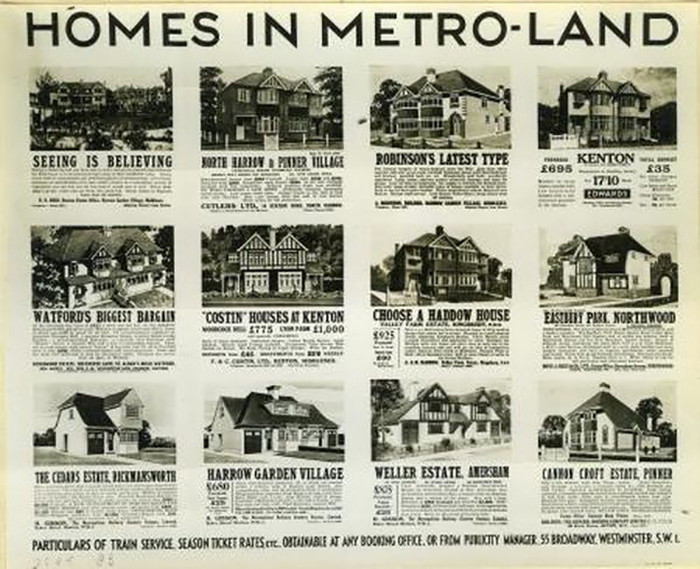
London Transport advert, showing the very similar Mock Tudor houses available on the new estates.
Steam services were still being used on services out to Metro-land, with the ‘H’ Class being introduced in 1920. This 4-4-4 tank locomotive was used on express services between Aylesbury and Harrow (later Rickmansworth) where services became electric. Probably the most famous Metropolitan locomotive was the Metrovick. Twenty of these electric units entered service between 1922 and 1923, produced by extensively rebuilding the original twenty electric locomotives from 1904/5. Each locomotive was named after a person associated with the Metropolitan area.
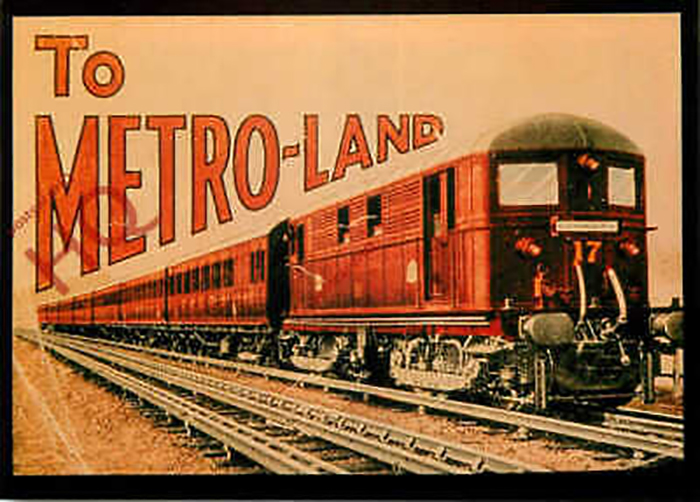
Postcard showing a Metrovick locomotive.
The British Empire Exhibition was held in 1924 and 1925, and Wembley Park station was rebuilt with a new island platform to accommodate visitors. This also helped with increased passenger numbers, as the new national stadium at Wembley had been completed the year before. Throughout the 1920s the suburban idyll of Metro-land was played up by the Met, creating a ‘faux bonhomie’ in the words of composer Constant Lambert. Although many people moved to the new communities and their ‘Tudorbethan’ semi-detached houses, the suburbs were not necessarily the pre-industrial English fantasy that they had been sold by the marketing.
The ‘Metro-land’ title was dropped in 1933 when the Metropolitan Railway was amalgamated into the London Transport Passenger Board, along with other public transport in London. The route became the Metropolitan Line of London Transport (LTPB’s public brand), and steam services were taken over by the LNER. The Metropolitan’s 70-year period as an independent railway was over, but it had the legacy of transforming London and travel forever.